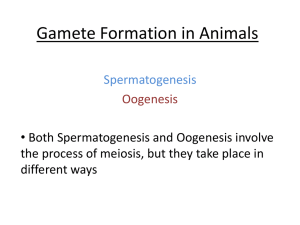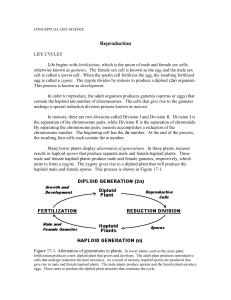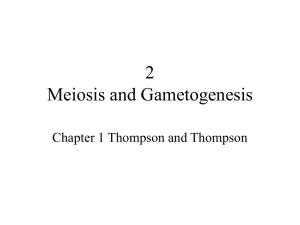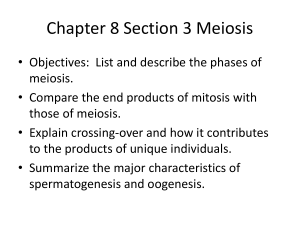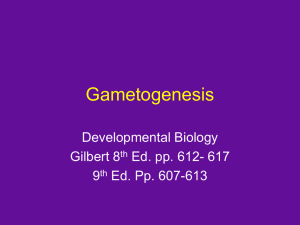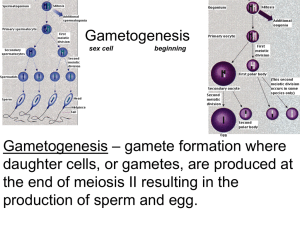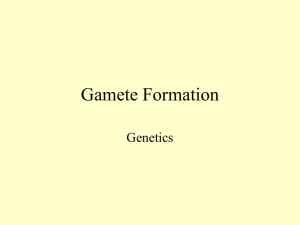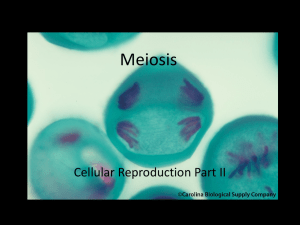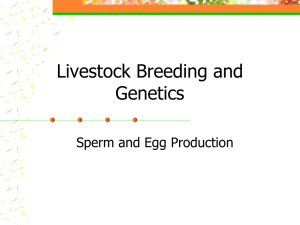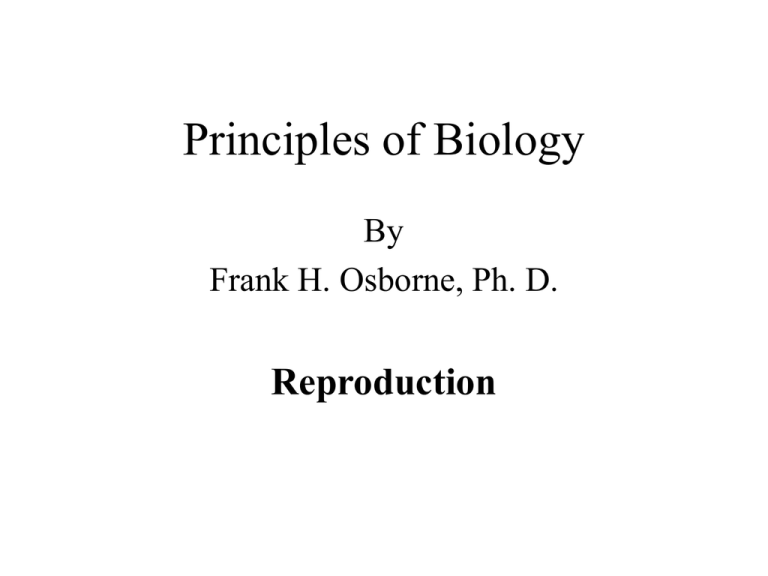
Principles of Biology
By
Frank H. Osborne, Ph. D.
Reproduction
Life Cycles
•Life begins with fertilization, which is the union
of male and female sex cells, otherwise known
as gametes.
•The female sex cell is known as the egg and the
male cell is called a sperm cell.
Life Cycles
•When the sperm cell fertilizes the egg, the
resulting fertilized egg is called a zygote.
•The zygote divides by mitosis to produce a
diploid (2n) organism. This is a process
known as development.
Life Cycles
•In order to reproduce, the adult organism
produces gametes (sperms or eggs) that contain
the haploid (n) number of chromosomes.
•The cells that give rise to the gametes undergo a
special reproduction process known as meiosis.
Human
Life
Cycle
Frog
Life
Cycle
Life Cycles
•In meiosis, there are two divisions called
Division I and Division II.
•Division I is the separation of the chromosome
pairs, while Division II is the separation of
chromatids.
Life Cycles
•By separating the chromosome pairs, meiosis
accomplishes a reduction of the chromosome
number. The beginning cell has the 2n number.
At the end, the resulting four cells each contain
the n number.
Life Cycles
•Many lower plants display alternation of
generations. In these plants, meiosis results in
haploid spores that produce separate male and
female haploid plants.
Life Cycles
•These male and female haploid plants produce
male and female gametes, respectively, which
unite to form a zygote. The zygote gives rise to a
diploid plant that will produce male and female
spores.
Moss
Life
Cycle
Gametogenesis
•Gametogenesis is the formation of sex cells, each
with the n, or haploid, number of chromosomes.
•The first step in gametogenesis is meiosis. The
process of meiosis consists of two divisions
separated by a period of time called interkinesis.
The individual chromosomes, however, separate
only once.
Stages of Meiosis
•Division I--separation of chromosome pairs
–Prophase I - chromosomes get short and thick
–Metaphase I - chromosome pairs line up in the
center of the cell
Stages of Meiosis
•Division I--separation of chromosome pairs
–Anaphase I - the chromosome pairs separate. One
set goes to one pole of the cell while the other goes to
the opposite pole of the cell.
–Telophase I - two daughter nuclei form, each with
n chromosomes. Cytokinesis follows. The result is
two haploid cells.
Stages of Meiosis
•Interkinesis--a period between the two divisions
–The length of interkinesis depends on the organism
involved.
–Some species have interkinesis periods that are
very short. Other organisms may have years
between the two divisions.
Stages of Meiosis
•Division II--separation of chromatids
–Prophase II - chromosomes shorten and thicken
–Metaphase II - chromosome line up in the center of
the cell
Stages of Meiosis
•Division II--separation of chromatids
–Anaphase II - the chromatids separate. One set of
chromatids goes to one pole of the cell while the
other goes to the opposite pole of the cell.
–Telophase II - the daughter nuclei form and
cytokinesis occurs.
Stages of Meiosis
•Each of the haploid cells from Division I enters
Division II. A total of four nuclei result. The
fate of these nuclei depends upon whether the
meiosis is part of gametogenesis in a female or
gametogenesis in a male.
Oogenesis
•Gametogenesis in females is called oogenesis.
•Oogenesis results in the formation of the egg
cell by meiosis.
•Each human female receives about 700,000
oogonia in her ovaries. During each
menstrual cycle, one oogonium becomes the
primary oocyte (which is a 2n cell) while the
cells surrounding it become the follicle.
Oogenesis
•The primary oocyte divides by Meiosis Division I
to produce a secondary oocyte.
•The other nucleus resulting from Division I is a
throw-away nucleus known as a polar
body.
•A polar body consists of the chromosomes and
nucleus resulting from meiotic division but it
receives almost no cytoplasm. All the cytoplasm
is found in the secondary oocyte.
Oogenesis
•After interkinesis, the secondary oocyte divides
by Meiosis Division II to produce the egg cell and
a polar body. The earlier polar body also divides
to form two polar bodies.
•The result is the egg cell and three polar bodies.
•Uneven cytoplasmic division is advantgeous in
that the cytoplasm will provide energy to the
developing embryo until it implants.
Oogenesis
Oogenesis
Spermatogenesis
•The testes contain millions of spermatogonia.
•Each of these cells can develop into a primary
spermatocyte. A primary spermatocyte will
undergo Meiosis Division I to produce two
secondary spermatocytes.
•Finally, each secondary spermatocyte undergoes
Meiosis Division II resulting in four sperm cells.
Spermatogenesis
•Each sperm cell receives the same amount of
cytoplasm. Spermatogenesis results in equal
distribution of the cytoplasm, in contrast to
oogenesis which has unequal cytoplasmic
division.
Spermatogenesis
Spermatogenesis
Female Reproductive System
•The female human has two ovaries, each of which
is associated with an oviduct. The oviducts
connect with the uterus.
•Sperm are introduced into the uterus via the
vagina and cervix. They swim up the uterus and
into the oviducts where fertilization takes place.
Female Reproductive System
•Ovulation is the process in which the egg leaves
the ovary. Ovulation is under the control of two
hormones.
•Follicle stimulating hormone and leutenizing
hormone stimulate the egg and its follicle to
develop. During the menstrual cycle the blood
levels of these two hormones increase to a peak.
Female Reproductive System
•Ovulation occurs just after the levels reach a
peak.
•If the egg remains unfertilized, the uterine
lining breaks down and menstruation occurs.
•Then the whole cycle repeats itself the next
month.
Male Reproductive System
•Sperm are produced in the testes, which are
found outside the body.
•Upon leaving the testes, the sperm travel up
the vas deferens, and into the seminal vesicle
from which they are released through
the urethra.
Male Reproductive System
•Fertilzation takes place most often in an
oviduct. The sex of the person is
determined when the gametes
unite. Then the cleavage stages of
development begin.
The End
Principles of Biology
Reproduction

